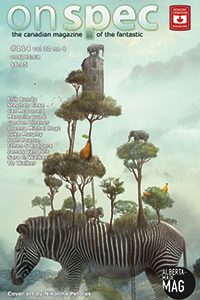Paul Di Filippo reviews John Crowley
The Chemical Wedding, by John Crowley (Small Beer Press 978-1618731081, $16.00, 224pp, trade paperback) December 6, 2016
 John Crowley is a cruel man. Or just a meticulous, painstaking artist. Take your pick. For years now, he has been tantalizing attendees at his public readings with excerpts from a brilliant weird novel narrated by a crow (his totemic animal?) But when we hear delightedly of a new Crowley book, is it the legendary crow saga, at last? No! It’s Crowley’s mad, capricious and hypnotically glorious retelling of a 400-year-old book which he has the temerity to dub, during an interview in the Guardian newspaper, “the first science fiction novel,” thus upsetting all kinds of canonical academic apple carts. The man is a fiend, I tell you!
John Crowley is a cruel man. Or just a meticulous, painstaking artist. Take your pick. For years now, he has been tantalizing attendees at his public readings with excerpts from a brilliant weird novel narrated by a crow (his totemic animal?) But when we hear delightedly of a new Crowley book, is it the legendary crow saga, at last? No! It’s Crowley’s mad, capricious and hypnotically glorious retelling of a 400-year-old book which he has the temerity to dub, during an interview in the Guardian newspaper, “the first science fiction novel,” thus upsetting all kinds of canonical academic apple carts. The man is a fiend, I tell you!
But if we cannot have brand-new unadulterated Crowley, due to his slow and steady monumental laboring, then we must be happy with what we do have: Crowley admixed with original author Johann Valentin Andreae. And of course, being pleased with this stimulating and readable production is not actually very hard work at all.
Crowley’s introduction lays out concisely and intelligently the context for the original publication of this early novel; the historical fallout of the book’s mysterious appearance; and finally its probable raison d’etre. To abridge this fascinating information: the book appeared in 1616, perfectly timed, as kind of a proto-viral hoax, to take advantage of widespread interest in secret, esoteric alchemical teachings, and was written by a literary fellow who had no real adherence to the sects and cults. It purports to be the first-person account by one “Christian Rosencreutz” of a journey he made to a hidden castle where a highly symbolic wedding was to take place. The book is structured as a seven-day pilgrimage and labor and celebration, although, as Crowley reveals, a further eighth day’s happenings come into play. And all of this prefatory material will be supplemented by Crowley’s frequent annotations in footnote form.
Given that Crowley, in addition to having an outlaw fabulaic soul and mind, also teaches at Yale, this material could have come off as stultifyingly academic. Instead, it is playful and speculative, even admitting ignorance and uncertainty when called for. His glosses offer plenty of added value to the text.
But what of the narrative itself, even rendered into fresh prose with Crowley’s skills? It proves to be quite entertaining and propulsive, not stodgy and archaic. The story-telling holds the attention of twenty-first-century jaded readers.
On Day One we meet our hero, an older fellow, unprepossessing yet erudite. He receives a supernatural passport to attend a mysterious holy union. He sets out “hopefully and joyfully on the way.” Day Two finds him in a Dante-esque forest, forced to choose among four paths. Eventually he attains his destination, a castle big as a city, it seems, but is immediately put through initiations and tests.
The Third Day is a long chapter and pivotal. Our hero passes his exams and joins the elite, a group of men who will become the Knights of the Golden Stone. He tours the facilities of the place, including supernatural appurtenances, and is finally escorted by beautiful handmaidens to his chamber for sleep. On Day Four he arises late and is conducted along with his peers to finally meet the King and Queen of the place, where the visitors are presented as helpful advisors. There are actually other royal couples present too, of various emblematic natures. The day culminates in the ritual execution of all the nobles.
Day Five finds our hero along with the other Knights-to-be travelling by boat to an island with a tower where they will perform duties leading to the resurrection of the primary royals on Day Six. Day Seven is feasting and celebrations back on the mainland—with a surprising end for Christian, as some earlier transgressions seem to leave him in a less-than-enviable position. Crowley’s final new text seeks to recreate the aftermath of Day Eight which Andreae left unwritten.
The attractions of this tale inhere in several realms. First, as Crowley affirms, these people come off as real folks, not just tokens of alchemical rites. Christian’s self-doubt and fears, his pride and altruism make us eager to follow his journey. The second attraction of the tale is all the beautiful little naturalistic or whimsical touches. Did you know that singing mermaids would be happy to get a long red scarf as the payment for their performance? And finally, the frissons of estrangement at the arcane doings should entice any lover of the fantastic.
And so, while not as consciously literary as A Voyage to Arcturus or The Manuscript Found in Saragossa, The Chemical Wedding offers many of the same pleasures as those two allegories.
Finally, we must applaud the stellar illustrations by Theo Fadel, whose work reminds me of New Yorker magazine favorite Barry Blitt, with maybe a trace of Breughel: sharp wavery line work full of energy and life.
The world has seen numerous modern editions of the Iliad and Odyssey and Beowulf, all intended to attract new audiences. Tolkien redid Sir Gawain and the Green Knight. But it took an offbeat, Hermetic mind like John Crowley’s to reanimate The Chemical Wedding.





